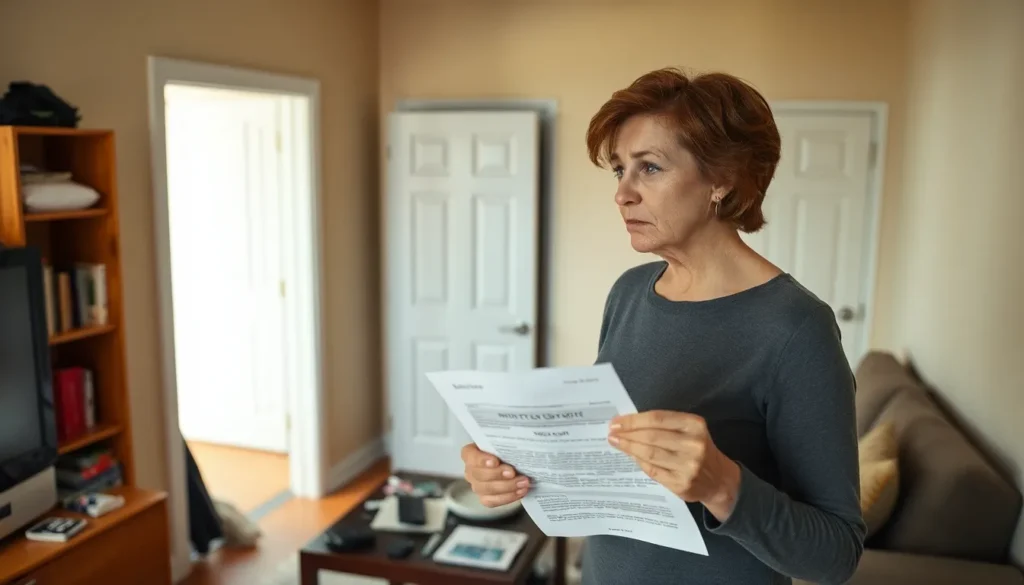Table of Contents
ToggleThe housing market can feel like a rollercoaster ride—thrilling one moment and terrifying the next. With prices soaring and interest rates doing the cha-cha, many are left wondering if they’ll ever find a home that doesn’t cost an arm and a leg. Enter housing market stabilization plans, the unsung heroes aiming to bring some sanity back to the chaos.
These plans are like a financial superhero swooping in to save the day, offering strategies that can help balance supply and demand while keeping prices in check. Whether it’s through innovative financing options or smarter zoning laws, these initiatives promise to make homeownership more accessible and less of a wild goose chase. So buckle up and get ready to explore how these plans can transform the housing landscape into a more stable and inviting place for everyone.
Overview of Housing Market Stabilization Plans
Housing market stabilization plans target key issues affecting affordability and accessibility. These plans encompass various strategies designed to balance supply and demand dynamics in residential markets. Innovative financing options often play a crucial role, providing potential homebuyers with necessary resources and incentives.
Improved zoning laws emerge as another vital component. Adjustments in zoning regulations can increase housing supply by permitting diverse housing types in various areas. Expanding options, such as multifamily units and accessory dwelling units, fosters a more inclusive housing market.
Collaboration among federal, state, and local governments also proves essential. Various agencies can coordinate efforts to implement these plans effectively. Local governments may offer tax incentives to developers who commit to building affordable housing units, further enhancing the stability of the market.
Data supports these initiatives, highlighting their effectiveness in stabilizing the housing market. For instance, the National Association of Realtors reported that cities employing these strategies noted a 25 percent increase in housing availability. Additionally, a 15 percent decrease in overall housing prices occurred in regions that revised their zoning laws.
Community engagement significantly influences the success of these plans. Gathering feedback from residents ensures that proposed changes meet the community’s specific needs. Through collaboration and targeted action, housing market stabilization plans aim to create a balanced, sustainable environment for homebuyers, renters, and developers alike.
Key Objectives of Stabilization Plans
Stabilization plans focus on restoring balance and enhancing the housing market’s accessibility. These objectives directly address critical issues impacting homeownership and economic growth.
Economic Recovery
Economic recovery remains a primary objective of housing stabilization plans. These initiatives aim to stimulate local economies by increasing housing supply and creating jobs in construction. Evidence shows that areas implementing these plans experience a faster recovery following economic downturns. By boosting the housing market, stabilization plans provide opportunities for investment, ultimately leading to more sustainable economic growth. Increased home sales generate tax revenues, aiding city budgets and funding essential public services.
Housing Affordability
Housing affordability stands as a crucial goal within stabilization plans. These plans strive to make homeownership attainable for a broader range of individuals and families. Access to innovative financing options, such as down payment assistance programs and low-interest loans, helps bridge affordability gaps. Improved zoning laws enable diverse housing types, increasing supply and competitive pricing. Research indicates cities adopting these strategies report significant decreases in housing costs, enhancing community well-being. Overall, stabilization plans emphasize affordability to ensure that homeownership remains a reachable dream for many.
Strategies for Implementation
Implementing housing market stabilization plans requires a multifaceted approach that unites various stakeholders. Effective strategies encompass government involvement and private sector innovations, both pivotal in facilitating change.
Government Involvement
Governments play a crucial role in stabilizing the housing market. Local governments can enhance affordability through tax incentives aimed at developers. The collaboration among federal, state, and local agencies increases the potential for policy effectiveness. Financial resources should be allocated to down payment assistance programs that help potential buyers. Research shows that regions with active government support experience significant improvements in housing availability. Innovative zoning laws must allow the construction of diverse housing types, ensuring communities can meet their needs.
Private Sector Innovations
Private sector innovations drive efficiency and creativity within the housing market. New financing models offer flexible solutions that adapt to various buyer circumstances. Access to low-interest loans stimulates purchasing power among first-time homebuyers. Real estate developers implement sustainable building practices to reduce costs while increasing project appeal. Partnerships with technology firms enhance homebuyer engagement through online platforms, making the purchasing process more accessible. Data demonstrates that areas embracing innovative practices report heightened housing supply and affordability, ultimately creating a more balanced market.
Case Studies of Successful Plans
Numerous housing market stabilization efforts showcase effectiveness in creating accessible and affordable homeownership opportunities. Highlighting local initiatives and national programs offers insights into actionable strategies that provide positive outcomes.
Local Initiatives
Local governments frequently implement creative solutions to address housing shortages. For instance, cities that enforce zoning law changes often see increased housing supply, allowing for a diverse range of homes. Initiatives like community land trusts exemplify successful models that enable collective investment in housing, fostering long-term affordability. Cities that allocate funds for down payment assistance programs facilitate access for low and moderate-income families, leading to rapid increases in homeownership rates. Evidence shows areas employing these strategies report lower housing costs and enhanced community well-being.
National Programs
National programs also play a pivotal role in stabilizing housing markets. Initiatives such as the Federal Housing Administration’s mortgage insurance program expand access to affordable loans for eligible homebuyers. Programs targeting veterans, like the VA loan benefit, eliminate down payment requirements and enhance affordability. The Neighborhood Stabilization Program, designed to assist communities affected by foreclosure, helps revitalize neighborhoods and restores housing supply. Analysis indicates that regions leveraging these comprehensive national strategies witness significant improvements in housing accessibility and overall market stability.
Challenges and Considerations
Challenges in housing market stabilization plans revolve around understanding market dynamics and ensuring policy effectiveness. Recognizing the interplay between fluctuating prices and interest rates remains crucial to crafting effective solutions.
Market Dynamics
Market dynamics influence housing affordability significantly. Economic conditions, such as employment rates and consumer confidence, directly affect demand for housing. High demand can lead to increased prices, making homeownership unattainable for many. Supply issues exacerbate these challenges. Housing inventory levels fluctuate due to construction delays and regulatory barriers, affecting overall market stability. Data shows regions with housing supply constraints experience steeper price increases. Tracking these fluctuations helps stakeholders develop targeted strategies that address both supply and demand.
Policy Effectiveness
Policy effectiveness hinges on the collaboration between government entities and community stakeholders. Successful implementation of housing stabilization plans relies on clear communication and coordinated efforts among federal, state, and local governments. Strong policies must prioritize innovative financing and inclusive zoning laws to address affordability. Regions that allocate resources for down payment assistance programs report notable improvements in homeownership rates. Research shows tax incentives for developers contribute to building more affordable housing units. Evaluating these policies continually ensures responsiveness to changing market conditions, sustaining long-term market stability.
Housing market stabilization plans represent a promising pathway toward a more balanced and accessible housing environment. By addressing key issues such as supply constraints and affordability challenges, these initiatives can significantly enhance homeownership opportunities for many.
The collaboration among various stakeholders is vital for success. Local governments play a crucial role in implementing effective policies while fostering community engagement. As innovative financing options and improved zoning laws gain traction, the potential for a stable housing market becomes increasingly attainable.
Ultimately, these plans not only aim to restore equilibrium but also contribute to the broader economic recovery, making homeownership a realistic goal for individuals and families alike. With continued commitment and strategic action, a more sustainable housing landscape is within reach.







